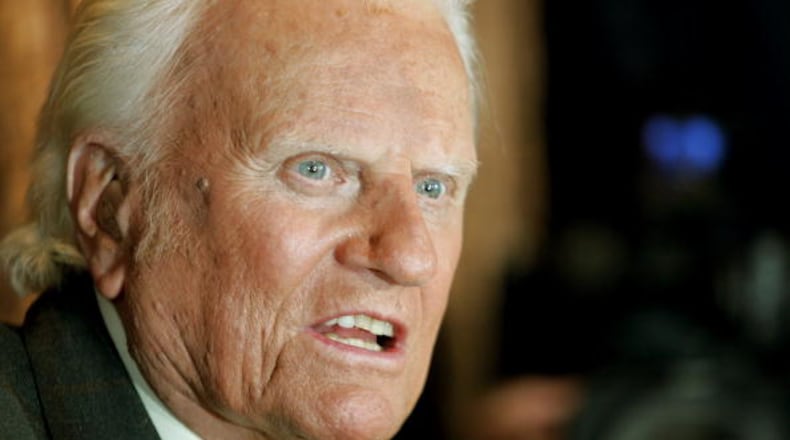“This is not mass evangelism,” Billy Graham was known to say,“but personal evangelism on a mass scale.”
Indeed, the famed evangelist who died Wednesday at his home in North Carolina was renowned for being one of the first preachers to harness the power of mass media to spread the word to millions around the world.
In 2007, the Billy Graham Evangelistic Association estimated that he had preached the Gospel to more than 215 million people in more than 185 countries and territories -- reaching hundreds of millions more through satellite broadcasts, TV , videos and film.
So encompassing was his media reach, in fact, that in 1989 he became the first member of the clergy to get his own star on Hollywood’s Walk of Fame. And his audience even included some unlikely celebrities. In the 1970s, John Lennon became a fan of watching Graham’s televised sermons.
“He saw himself as using new media to deliver a very old message,” Randall Balmer, an expert on American religious history at Dartmouth College, told CNN about Graham.
It all started with radio. In 1943, Mr. Graham accepted the pulpit of the First Baptist Church in Western Springs, Ill., a Chicago suburb. He quickly became well known for his sermons and that same year, he was invited by a Chicago radio station to take over itsweekly Sunday show, “Songs of the Night.” Seeing the power radio had to reach many more people, when he established the Billy Graham Evangelist Association seven years later, he also launched the weekly “Hour of Decision” radio show.
The show was picked up by ABC radio which sent it out to 150 stations. At its peak, the show was carried by 1,200 stations nationwide.
Soon enough, TV came calling. In 1957, Graham brought his crusade to New York City, an event that expanded to 16 weeks and was attended by 2.3 million people. ABC televised it one night, a live program known as “Gospel in Gotham.” The pattern was set and soon whenever Graham conducted a crusade it would be syndicated on TV or made available via webcast or satellite. In 1993, a five-night so-called “electronic crusades” in Germany reached an estimated 55 million people in eight countries via satellite.
Graham also used television to address and comfort millions of people at difficult times, as when he led the nationally televised memorial service for 168 victims of the bombing of the Alfred P. Murrah Federal Building in Oklahoma City in 1995. Carried live by major broadcast and TV networks, it reached millions of people watching at work or in their living rooms.
Today, the Trinity Broadcasting Network airs "Billy Graham Classics" weekly. As further evidence of the power of TV to move people immediately the Billy Graham Evangelistic Association has call centers at its headquarters and in other areas of the country staffed by trained volunteers. This "TV Telephone Ministry" fields calls from viewers of the "Billy Graham Classics" who have questions or problems for which they're seeking guidance.
The Billy Graham Evangelistic Association also makes available online a wealth of classic Graham sermons, specials and "messages of hope."
About the Author




